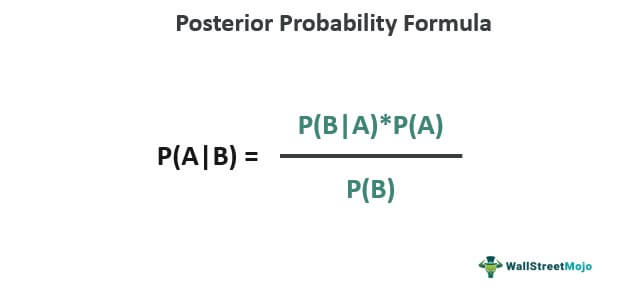Table Of Contents
What is Posterior Probability?
The posterior probability refers to a method based on the Bayesian interpretation of probability. The method involves the calculation of new probability by updating the prior probability in response to the new evidence. In essence, it is an application of Bayes’ theorem.
Applying Bayes' theorem, the existing probability of an event becomes a prior probability (before observing the evidence) when new evidence comes into the observation. The updated probability (probability based on observed evidence) is derived by applying the likelihood of evidence to the prior probability.
Key Takeaways
- The posterior probability refers to the updated probability of an event obtained by applying the new evidence formed. Its basics are underpinned by conditional probability and Bayes' theorem.
- The formula for calculations is P(A|B) = P(B|A)*P(A)/P(B)
- The important elements are prior probability P(A), evidence P(B), P(B|A) is the likelihood function.
- As new evidence emerges and is integrated into the computation, a posterior probability might become a prior for a new updated posterior probability.
Posterior Probability Explained
The posterior probability is an important tool in representing the uncertainty of specific events. It considers all evidence available, and when it considers the latest information to recalculate the existing probability to get the new one and discard the prior one, it reveals that its basics are underpinned by the concept of conditional probability determined by the Bayes' theorem. The revised probability depends on a second or new event's conditional and unconditional probability.
It is comparable to the human thought process. People's choices and conclusions are always sensitive to new information, experience, or intuitions. It is a deliberate procedure that thoroughly considers the numerous ways an event may or may not occur. In this approach, people's judgments concerning random outcomes are correctly influenced by posterior facts during ambiguous environments. Hence, this technique is important in finance, data science, medicine, etc.
Formula
The Bayes theorem posterior probability formula is:

Where:
- P(A|B) = The probability of event A occurring, provided the evidence B (posterior probability)
- P(A) = Probability of event A occurring (prior probability)
- P(B) = Probability of event B occurring (evidence or marginal likelihood)
- P(B|A) = The probability of event B occurring, provided the evidence A (likelihood function)
- "|" means "provided"
Calculation Example
Imagine a box having 50% dark chocolates and 50% white chocolates. Half of the dark chocolate is wrapped in gold paper and another half in silver paper. All the white chocolates are wrapped in silver paper. A kid picked chocolate from the box, wrapped in silver paper. What is the probability that the picked one is dark chocolate?
- The event D is that the picked chocolate is dark.
- The event S is that the picked chocolate is wrapped in silver paper.
According to variational Bayesian methods:
- Posterior probability: P(dark chocolate|silver wrapping): P(D|S): It is the probability that the chocolate picked is "dark chocolate," given the evidence of "chocolate wrapped in silver paper."
- Likelihood function: P(silver wrapping|dark chocolate): P(S|D): The probability of the evidence given the parameter; the probability of silver wrapping given the chocolate type is dark chocolate.
- P(D): The probability that the selected chocolate is "dark chocolate" given no prior information. The probability P(D) is 50%, 0.5.
- P(W): The probability that the selected chocolate is "white chocolate" given no prior information. The probability P(W) is 50%, 0.5.
- P(S|D): The probability of chocolate wrapped in silver paper and given that it is dark chocolate is 0.5 (50% of dark chocolate is covered in gold paper and the remaining 50% in silver paper).
- P(S|W): The probability of chocolate wrapped in silver paper and given that it is white chocolate is 1 (since all white chocolates are wrapped in silver paper).
- P(S): Probability of randomly picked chocolate is wrapped in silver paper given no prior information.
- P(S): Probability of randomly picked chocolate is wrapped in silver paper given no prior information.
P(S)= P(S|D).P(D) + P(S|W).P(W)
=0.5*0.5 + 1*0.5
=0.75
Applying the above findings into the formula to calculate posterior probability:
- P(D|S)= P(S|D)*P(D)|P(S)
=0.5*0.5|0.75
=0.3333
=33.33%
Hence the probability of random chocolate selected is "dark chocolate," with the evidence that the chocolate wrapping is silver in color is derived as 33.33%. Academics also uses posterior probability calculators to get quick results.
